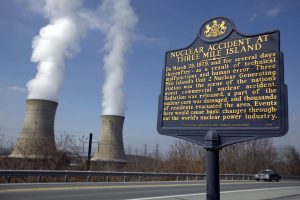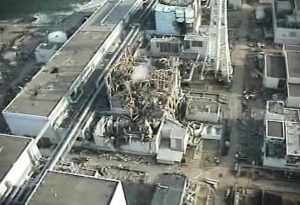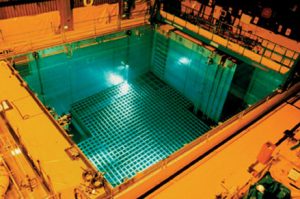While it is true that the precise details of the meltdown sequence and explosion at Chernobyl could not happen at any commercial reactor operating in the US, it is untrue that a radiological disaster of the same scale could not happen in the US. In fact, a similar event at a reactor site in the US could be just as severe or worse.
The reactors at Chernobyl utilized a different reactor core design than is used at US reactors. The RBMK-style reactors at Chernobyl and other Soviet Union-designed power plants use blocks of graphite as a neutron moderator, whereas reactors currently operating in the US do not. While graphite is the most chemically stable version of carbon, at the extreme temperatures of a reactor core, it can easily catch fire. When the power surge and steam explosion occurred in the Chernobyl unit 4 reactor, it blew the core and the reactor building apart, exposing the graphite to air at extreme temperatures. This ignited the graphite and created a massive fire that burned for several days. The intensity of the fire lifted the radioactive contaminants higher into the atmosphere, leading to widespread contamination throughout Europe, Asia, and the northern hemisphere.
Meltdowns with US Reactor Designs: Three Mile Island and Fukushima

Reactors in the US do not employ graphite cores, but could still release massive amounts of radiation in a catastrophic accident—a fact proven by both the Three Mile Island (TMI) and Fukushima Dai-Ichi meltdowns. The loss of coolant leads to the generation of large amounts of hydrogen gas because of a chemical interaction between steam and the type of metal cladding on the fuel rods: zirconium alloy, which can also be flammable at high temperatures. (Zirconium is the material that used to be used in camera flash-bulbs.) The disaster at TMI released large amounts of radioactive gases. While the containment building itself did not blow apart the way the reactor building at Chernobyl did, contaminated coolant water released from the reactor was pumped out of the containment building into an adjacent building, where the radioactive gases vented to the atmosphere, starting within two hours of the initial malfunction. Also, a hydrogen explosion occurred in the containment building about eight hours into the event, releasing a large amount of radioactive material. Significant releases continued for several days. There were no reliable measurements of the amount of radiation released because the monitors on site were designed to detect low levels of radiation, and were fried out early on by the high levels of radiation that were released.

The reactors at Fukushima Dai-Ichi suffered three successive hydrogen explosions that blew apart their containments and vented large amounts of radioactive material. All three of the six reactors that were operating at the time of the earthquake and tsunami melted down and their containment systems failed. They are of the same design as dozens of reactors still operating in the US: General Electric boiling water reactors (BWRs). The containments of GE BWRs, especially of the Mark I and Mark II varieties most common in Japan and the US, have been known to be highly vulnerable to failure since the 1970s, and have been compared to the Soviet RBMK design as the “American Chernobyl”. The impacts of Fukushima on Japan were partly mitigated by chance: for much of the first several days of the disaster, prevailing winds were blowing mostly out to sea, rather than inland as they usually do. Had the winds been turned the other way, far greater contamination of the surrounding communities and further downwind could have resulted.
Fuel Pool Fires

What is more, perhaps the greatest danger involving nuclear power in the US is not a reactor meltdown, but a fire in one of the pools where nuclear waste is stored at reactor sites. Irradiated fuel pools contain the used fuel assemblies removed from the reactor every 18-24 months. At nearly every reactor, these pools have been re-racked to maximum density, storing several reactors’ worth of nuclear fuel, packed about as densely as in the core. Fuel pools are located outside of the containment structure, in standard commercial-grade buildings. If a pool ruptured or was drained, the fuel could spontaneously ignite and catch fire, leading to massive amounts of contamination, likely far greater than Chernobyl. This risk is more or less unique to the US, as most other countries do not permit high-density racking of fuel pools.



